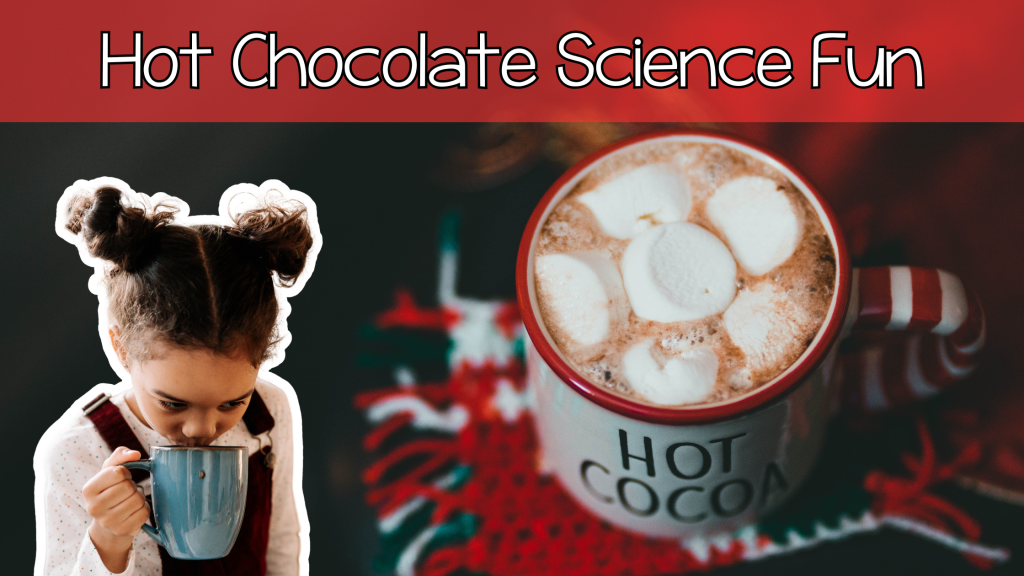Sure, hot chocolate is an awesome treat during the cold winter months…but it’s also a great way to add some science learning with young children. From melting marshmallows to mixing cocoa powder, these hot chocolate science activities give children a chance to explore concepts like dissolving, floating, density, and more. These hot chocolate science experiments are easy, educational, and fun to add to your early childhood classroom. These experiments can be done with a whole group or individually with each child.
Will hot chocolate/cocoa powder dissolve faster in hot water or cold water?
Place a cup of hot water and a cup of cold water on a table. Have children predict which will dissolve faster. Add cocoa powder to each and stir. Observe that hot water helps it dissolve faster.
Simplified Explanation for Kids – Hot water helps the cocoa powder break apart faster because it makes the water move more quickly, like a dance party for molecules! Stirring makes the party even wilder, helping the cocoa mix into the water. Cold water moves slower, so it takes longer to mix everything together.
Extension Questions and Experiments: What happens if we stir faster? What if we use milk instead of water? Compare to stirring with a spoon and a whisk.
Which liquid will dissolve a marshmallow the fastest?
Set out four clear cups…filled with hot water, cold water, milk and vinegar. Ask children to predict which liquid will dissolve the marshmallow the fastest. Place one marshmallow in each cup of liquid, and observe how they change over time.
Simplified Explanation for Kids – Marshmallows are made of sugar, air, and gelatin. When you put them in hot water, the heat makes the sugar and gelatin break down faster, so the marshmallow dissolves. In cold water, everything happens more slowly. Vinegar is acidic, so it breaks the marshmallow apart quickly, like magic!
Extension Questions and Experiments: Add food coloring to the liquids to observe how the marshmallow absorbs or interacts with the color. What if we freeze the marshmallows first?
Which items will sink in hot chocolate? Which items will float in hot chocolate?
Make a cup of hot chocolate. Provide a variety of items (marshmallows, chocolate chips, cinnamon Sticks, peppermint candies, etc.). Have children predict if each item will sink or float in the hot chocolate. One at a time, place each item in the hot chocolate to see if it floats or sinks.
Simplified Explanation for Kids – Objects float if they are light and full of air, like marshmallows. If they are heavy and packed tightly, like chocolate chips, they sink. Water tries to push everything up, but if something is too heavy, gravity pulls it down!
Extension Questions and Experiments: Test the same objects in hot and cold water. Track how long each floating item takes to sink as it absorbs water (if applicable).
What happens to the colors when we add vinegar and baking soda?
Mix hot chocolate powder with hot water in three clear cups. Ensure the mix is evenly dissolved for consistent results. To each cup, add 2–3 drops of food coloring (e.g., red in one, blue in another, green in the last). Stir gently to distribute the color. Add 1/4 teaspoon of baking soda to one cup and stir. Observe the immediate reaction: fizzing, bubbling, and any change in color. Add 1 teaspoon of vinegar to another cup. Watch for fizzing and bubbling as the acid reacts with the hot chocolate mixture. Note any changes in color or texture. Combine the vinegar and baking soda solutions in a fourth cup and observe the vigorous reaction. Look for color changes and how the bubbles affect the appearance of the mixture.
Simplified Explanation for Kids –When we mix things like baking soda or vinegar into our hot chocolate, they do something special. Baking soda is like a ‘helper’ that makes things calmer, so the colors might get lighter. Vinegar is like a ‘power booster’ that makes the colors brighter and darker. When we mix baking soda and vinegar together, they get really excited and make lots of bubbles, kind of like a magic potion!
Extension Questions and Experiments: Why did the colors change? After adding baking soda or vinegar, gently swirl the cup with a straw or spoon to create marbled patterns.
Amazon Picks and Resources



